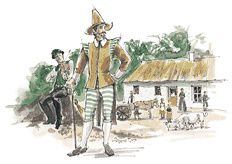 |
 | |||
 Irish DancesThe lighter jig is a faster dance than the jig, slip jig and heavy jig. The double jig is one of the most popular Irish dances. It commences with the rising step, one of the first steps taught to beginners. The right foot is lifted about 12 inches off the floor, the person hops on the left, while the right is lowered to tap the floor and then each foot in turn is lifted and lowered. This action is repeated three times to one bar of music.
Arm movement is discouraged in Irish dance, as the dancer is taught to demonstrate control and grace. However, there was a time in the early nineteenth century when vigorous arm The Irish word for reel is cor. In a 1598 book entitled News from Scotland there is the following quotation: "Silas Duncan did go before them playing this reill or dance upon a small trump." Both men and women dance the reel. For women, it is a light rapid soft shoe dance which allows for plenty of leaping. The reel is faster than the jig and has a 4/4 timing. One of the earliest references to Rince Fada (Long Dance) is in 1549 when a writer stated that there were similarities between the Irish and Scottish versions. There is a strong belief that the dance was brought to Scotland by migrant workers from Donegal and Derry. For the Rince Fada, the men stand in a row. The females face them in another row. Dancing begins at one end and gradually works through the line until all are dancing. The Harvest Time jig is a dance from the west of Ireland, dating from the eighteenth century. It was unusual that it only called for half as many men as women. The man would be in the centre with a woman on each side holding his hand and they would dance a jig. It originated at harvest time when there was a shortage of men, for at that time hundreds of harvesters left home to seek employment in other areas where work was plentiful, returning home when the season was over. > > > Read the final part of this article
From Irish Dance by Authur Flynn. Illustrated by Anne Farrall |
[ Back to top ]
All Material © 1999-2018 Irelandseye.com and contributors

 movements and swinging shillellaghs played a large part in the jig. From the early 1900s arm gestures were removed from the jig, in the same way that all arm movements have been eliminated from the Irish hornpipe. The jig was originally danced by sailors, imitating the motion of the ship. The only thing remaining of its seafaring origin is the rocking movement common to sailor's dances world-wide.
movements and swinging shillellaghs played a large part in the jig. From the early 1900s arm gestures were removed from the jig, in the same way that all arm movements have been eliminated from the Irish hornpipe. The jig was originally danced by sailors, imitating the motion of the ship. The only thing remaining of its seafaring origin is the rocking movement common to sailor's dances world-wide.